Tested positive for Group B Strep? Here’s what it means for your birth plan

titovailona/Twenty20
Plus the latest on a potential vaccine to prevent GBS infection.
A portion of this article has been excerpted from The Motherly Guide to Becoming Mama.
Table of Contents
- What is GBS?
- What causes GBS?
- How is the GBS test performed?
- What are the risks of having a GBS infection?
- What happens if I test positive for GBS?
- How will taking antibiotics in labor change my birth plan?
- What if I’m having a scheduled C-section?
- What if I deliver before I can get tested for GBS?
- Can I retest for GBS before labor?
- Will taking antibiotics in labor harm my baby’s microbiome?
- How can I lower my chances of testing positive for GBS?
- Is there a vaccine for GBS?
- How does Group B Strep affect babies?
- Frequently Asked Questions
- Should I be worried if I tested positive for group B strep?
- What happens if you test positive for group B strep?
- Can I get rid of group B strep?
- How did I get GBS?
- Should my husband be treated for group B strep?
- Is GBS an STD or STI?
- What happens if you are GBS positive and don’t get antibiotics?
- What antibiotic kills strep B?
- What antibiotic kills strep B in urine?
- A note from Motherly
In pregnancy, you’ll undergo a variety of routine scans and lab work, from anatomy scans to the oral glucose test, to ensure everything is progressing normally. Toward the end of your pregnancy (week 36 through week 37), your obstetrics provider will recommend a screening for group B streptococcus (GBS), aka the group B strep test.
Unless you’ve been pregnant before, you’ve likely never heard of GBS. A type of bacteria that colonizes the reproductive or urinary tract, GBS is not a sexually transmitted infection, nor is overgrowth related to a hygiene issue. Medical experts don’t actually know why some women have this bacteria and others don’t, but it is incredibly common, affecting as many as 20% to 30% of pregnant women.
And though we don’t know what causes GBS, testing for the presence of the bacteria during pregnancy—and undergoing treatment if you test positive—is something to be taken seriously. The risks to your infant can be dire. In the U.S., GBS infection is the leading cause of meningitis and blood infections within the first three months of life. The World Health Organization (WHO) estimates that infections caused by GBS in pregnant women are linked to 150,000 preventable stillbirths and infant deaths worldwide each year.
That’s a scary statistic that no one wants to think about, but knowing more about the risks associated with GBS and understanding your treatment plan can help you make the safest decision for your little one.
What is GBS?
Group B strep (GBS) is a type of bacteria that lives in the intestines and can move down to colonize the reproductive or urinary tract. According to the Centers for Disease Control and Prevention (CDC), about 1 in 4 pregnant women in the U.S. carry GBS in their body.
What causes GBS?
Experts aren’t entirely sure. GBS colonization can come and go, and most people with the bacteria show zero symptoms or signs of infection. Rarely, people with GBS colonization may have symptoms of a urinary tract infection.
Risk factors associated with GBS include:
- Having multiple sexual partners
- Engaging in male-female oral sex
- Having recent or frequent sex
- Using tampons
- Infrequent hand-washing
- Being less than 20 years old
How is the GBS test performed?
The test for GBS is performed by swabbing the vagina and rectum. It’s relatively quick. Test results are typically returned within 48 hours. The confusing thing about GBS is that you can test positive for GBS temporarily, intermittently or persistently—it all depends on timing.
That’s why the test is performed late into pregnancy—to hopefully get the most accurate picture of GBS status. But testing positive for GBS doesn’t necessarily mean that you’ll develop a GBS infection—or that your baby will. Nonetheless, it’s still safer to treat it as such.
If you test negative for GBS, nothing further needs to be done.
What are the risks of having a GBS infection?
In pregnancy (and during normal life), GBS can cause urinary tract infections, but many people who have it are asymptomatic. “However, if these bacteria are present in the vagina, and the baby comes in contact with them during birth, they can make the baby sick with a serious infection. This can lead to pneumonia, sepsis and even meningitis—an infection of the fluid in the brain and spinal cord,” writes midwife Diana Spalding, MS, CNM, in “The Motherly Guide to Becoming Mama.”
These risks, though severe, are relatively rare with treatment. According to statistics from the CDC, if you test positive for GBS and receive treatment, there’s a 1 in 4,000 chance of delivering a baby who will develop an infection related to GBS. If you test positive but do not receive treatment, that number jumps to 1 in 200.
Related: The new mama’s guide to pregnancy symptoms
“In a previous era, GBS infections had a 50% mortality rate, which is why there are strict guidelines in place to screen and treat GBS,” writes Spalding. “The guidelines have resulted in a dramatic reduction in the rate of infant infection since the 1990s.”
Now, it’s estimated that just 4% to 6% of babies who develop GBS disease may die (that’s 4 to 6 out of every 100). Babies at greater risk of infection and serious disease from GBS are typically those born preterm or with low birth weight.
While this is still very scary, Sarah Bjorkman, MD, OB-GYN and Motherly’s Maternal Health Advisor, affirms that neonatal infection with GBS is very rare, and more importantly, it can be prevented. “In the 1990s, before we started routine screening and treatment for GBS, it was the number one cause of early-onset sepsis,” she says in “The Motherly Guide to Becoming Mama.” “However, this is no longer the case as rates have dropped by more than 80% with screening and treatment. This is amazing! Antibiotics work, great evidence supports their use, and it could save their baby’s life. ACOG, AAP, ACNM and the CDC all recommend GBS prophylaxis/treatment, and so do I.”
What happens if I test positive for GBS?
Guidelines from the American College of Obstetrics and Gynecology (ACOG) and the CDC recommend giving pregnant women antibiotics through an IV during labor to prevent early-onset GBS infection in newborns. If you test positive for GBS and go into labor, you’ll want to head to the hospital right away so that you can start antibiotics, which work best when begun 4 hours before delivery.
“The drug of choice is penicillin, but if you are allergic, additional tests will be done to the bacteria to find another antibiotic that will work,” Spalding notes in “The Motherly Guide to Becoming Mama.”
Related: Yes, you CAN get pregnant with PCOS. A fertility expert shares how.
Taking antibiotics before you’re in labor won’t help, unfortunately, as the bacteria can grow back quickly. Antibiotics have to be circulating at the time of labor in order to fend off the colonization.
If you’ve already given birth to a baby who was infected with GBS, you will automatically receive antibiotics during your next labor, because your risks for developing an infection again may be higher.
How will taking antibiotics in labor change my birth plan?
Thankfully, taking antibiotics in labor shouldn’t drastically change your birth plan. If you’re planning on delivering at a hospital or birth center, you’ll have an IV placed in your arm to receive an antibiotic drip.
This shouldn’t greatly limit your movement. Antibiotics are only administered every four hours until birth, and only take about 15 to 30 minutes to run (this usually ends up being only once or twice for most people). During that time, you may have some limited mobility during labor, but you can still likely walk and move around or even be in a bath or birthing tub. You can ask to be saline-locked in the hours between IV usage so that you’re detached from the IV pole.
If you were planning on a home birth and you require antibiotics during labor, whether you are still able to deliver at home depends on your state. Many states don’t allow home birth midwives to administer an IV, but be sure to clarify this with your provider beforehand.
What if I’m having a scheduled C-section?
“Women who are having planned C-sections do not need to be treated for GBS but are usually tested,” Spalding writes. “If your water breaks or you go into labor before your scheduled Cesarean birth, it may become necessary to start treatment.” This is because if your membranes are no longer intact, your infant could have some exposure to the bacteria.
Related: Your guide to C-section recovery: Timeline, tips and what to expect as you heal
What if I deliver before I can get tested for GBS?
If your water breaks or you deliver before you’ve had access to a GBS test, the American Academy of Pediatrics (AAP) recommends that you tell a medical care provider right away that you have not yet had a GBS test. If you know you were positive for GBS in a previous pregnancy, also be sure to share this information.
Can I retest for GBS before labor?
No. Retesting is not recommended, because if you test positive the first time, it’s assumed that you have had a colonization and require antibiotics to reduce your risk of passing on an infection to the infant during birth. Even if you retook the test and your results were negative the second time, you’d still be treated as if you were positive.
In this regard, the information regarding GBS screening is not foolproof—and can seem a bit murky. While the test itself has a high rate of accuracy, it’s a simple fact that GBS colonization may come and go in people’s bodies. Because your GBS status can change after you have your screening, this may mean that some women are unnecessarily treated, and it may conversely mean that some cases are not detected.
Will taking antibiotics in labor harm my baby’s microbiome?
It’s possible. This is largely a case in which the benefits outweigh the risks, but it’s good to know the risks. “Providing antibiotics can affect the body’s microbiome at a time when babies need to be exposed to healthy microbes to jump-start their immune systems,” writes Spalding. “There’s also the risk of widespread antibiotic use creating bacteria that are resistant to antibiotics.” Like any treatment, it’s not without its potential for unwanted side effects.
One study demonstrated that infants whose mothers received IV antibiotics in labor had lower levels of Bifidobacterium, a type of beneficial bacteria. The long-term effects on this seem to be less pronounced if antibiotics are used for less than 24 hours (which is the case in many births). If antibiotics are used for more than 24 hours during labor, an association has been shown with an increase in childhood eczema by age 2, though more research is needed to confirm this.
Related: How to treat eczema in kids, according to a dermatologist
While yes, taking antibiotics could have a negative effect on your baby’s developing immune system, those same antibiotics can also be life-saving. An infant’s risk of developing GBS infection drops by 80% when antibiotics are used during labor. The risk to their developing microbiome seems to be lowest if you are able to use antibiotics for less than 24 hours.
There are also ways to rebuild your baby’s microbiome after birth. Skin to skin contact and breastfeeding can both be beneficial in seeding your infant with good bacteria. Breastfeeding for at least three months may mitigate the risk. If you do test positive for GBS and receive antibiotic treatment, talk to your obstetric care provider and your child’s pediatrician about giving your baby infant probiotics once born, in addition to breastfeeding.
How can I lower my chances of testing positive for GBS?
If you’re wondering whether you can prevent GBS colonization from happening in the first place, there are certain traditional remedies many women use to try to prevent and treat GBS. “This includes taking garlic, yogurt, tea tree oil, and more. Unfortunately, at this time the research around these methods is fairly limited, so we don’t know for certain that they will work,” writes Spalding. They may end up working for some women, but not for others.
There’s also some research around using oral probiotics in pregnancy (though results are mixed) and anecdotal evidence on using vaginal probiotics (as a suppository) in the third trimester leading up to the GBS test. Ask your obstetric care provider and/or a naturopath trained in herbal medicine and supplements for more information on this front. Dr. Romm also provides more resources on this.
Is there a vaccine for GBS?
Not yet. Experts from the WHO are now calling for a maternal vaccine to be taken in early pregnancy to prevent the disease. While some are in development, none are ready for distribution yet. In a recent report, WHO experts say that an effective vaccine offered to even 70% of pregnant people would prevent 50,000 deaths and 170,000 preterm births.
“The idea for a maternal Group B strep vaccine was suggested about four decades ago, but it is only in the last decade that more progress has been made, with now several promising candidates,” WHO report author Joy Lawn, director of the Maternal Adolescent Reproductive & Child Health Center at the London School of Hygiene & Tropical Medicine, tells Gizmodo. “And as we have learnt with Covid, it is good to have more than one.”
How does Group B Strep affect babies?
Understanding the impact of Group B Streptococcus (GBS) on newborns is crucial for expectant parents. While most babies born to mothers with GBS remain healthy, there are instances where GBS can lead to serious health issues in newborns. Here’s what you need to know about GBS and its potential effects on babies.
Understanding the Risk
GBS is the leading cause of sepsis and meningitis in newborns in the United States. Though the chance of your baby becoming ill from GBS is low—especially with proper treatment during labor—it’s important to understand the risks. If GBS is passed to a baby during delivery, it can lead to infections in different parts of the body, including the blood (sepsis), lungs (pneumonia), or brain (meningitis).
Symptoms in Newborns
Symptoms of GBS in newborns can be subtle or hard to detect at first. They may include fever, difficulty feeding, irritability, or lethargy. Babies may also have trouble breathing or exhibit an abnormal heart rate. It’s important to monitor newborns closely for these symptoms, especially in the first few days after birth.
Early-Onset vs. Late-Onset Disease
GBS diseases in babies are classified as either early-onset or late-onset. Early-onset disease occurs in the first week of life, typically within the first 24 hours after birth. This is most commonly associated with exposure to GBS during delivery. Late-onset disease occurs from one week to several months after birth and is not always linked directly to maternal transmission during birth.
Treatment for Affected Babies
If a baby shows signs of a GBS infection or was born to a mother who tested positive for GBS and did not receive antibiotics during labor, they will be treated promptly with antibiotics in the hospital. Early diagnosis and treatment are key to managing GBS-related complications in newborns effectively.
Preventive Measures
The good news is that with proper screening and treatment, the transmission of GBS from mother to baby can be greatly reduced. Mothers who test positive for GBS are given antibiotics during labor to decrease the risk of their baby developing the infection. This treatment has been highly effective in preventing early-onset GBS disease in newborns.
The Role of Caregivers
As a parent or caregiver, understanding the signs of GBS infection and seeking prompt medical care for your baby is crucial. If your baby shows any signs of illness or you know you tested positive for GBS during pregnancy, inform your healthcare provider immediately. Your awareness and vigilance are vital components in protecting the health of your newborn.
Long-Term Effects
Most babies who receive quick treatment for GBS infections recover completely and have no lasting effects. However, in rare cases, there may be long-term consequences, especially if the infection leads to meningitis. Regular follow-ups with your pediatrician can ensure any potential issues are addressed early on.
While the thought of GBS can be worrying for expectant parents, it’s important to focus on the effective preventive measures available. By understanding the risks, symptoms, and treatments related to GBS, you can play a crucial role in ensuring the health and well-being of your newborn. Remember, the goal of GBS testing and treatment is to ensure that every baby has a healthy start in life. With the right care and attention, GBS is a manageable condition, and the vast majority of babies born to GBS-positive mothers thrive.
Frequently Asked Questions
Should I be worried if I tested positive for group B strep?
Testing positive for GBS is common and not a cause for panic. It means you carry the bacteria, which is normal for many women. Your healthcare provider will recommend antibiotics during labor to reduce the risk of your baby becoming infected.
What happens if you test positive for group B strep?
If you test positive, your healthcare team will plan to administer antibiotics through an IV during your labor. This greatly reduces the chance of your baby developing a GBS infection.
Can I get rid of group B strep?
GBS colonization can be temporary. While there’s no guaranteed way to “get rid of” GBS before delivery, antibiotics given during labor can effectively prevent transmission to your baby.
How did I get GBS?
GBS is a common bacterium often found in the intestines, rectum, and urinary tract. It’s not acquired through sexual activity or poor hygiene. Many people carry GBS, and it can come and go naturally.
Should my husband be treated for group B strep?
GBS treatment is not required for partners since GBS is not considered a sexually transmitted infection. The focus is on preventing newborn infection during childbirth.
Is GBS an STD or STI?
No, GBS is not a sexually transmitted disease (STD) or sexually transmitted infection (STI). It’s a bacterium that many people carry in their body without knowing.
What happens if you are GBS positive and don’t get antibiotics?
If GBS-positive mothers do not receive antibiotics during labor, their babies are at higher risk for developing GBS-related complications like meningitis or sepsis. However, with appropriate treatment during labor, these risks are significantly reduced.
What antibiotic kills strep B?
Penicillin is the most commonly used antibiotic to treat GBS during labor. For those allergic to penicillin, other effective antibiotics are available, such as cefazolin, clindamycin, or erythromycin, depending on individual allergies and the bacteria’s resistance patterns.
What antibiotic kills strep B in urine?
If GBS is found in your urine during pregnancy, your healthcare provider may prescribe antibiotics such as penicillin or ampicillin to treat the infection and reduce risks to your baby.
A note from Motherly
While it’s important to protect the health of your baby’s microbiome, using antibiotics in labor if you are GBS positive can protect against serious GBS infection—and prevent dire consequences. It’s also helpful to know that studies show that the negative microbiome effects are relatively short-term, and can be mitigated with breastfeeding and using infant probiotics for at least the first three to six months of life. If you have more questions or concerns about the GBS test and treatment, talk to your obstetric care provider.
Sources:
Aloisio I, Mazzola G, Corvaglia LT, et al. Influence of intrapartum antibiotic prophylaxis against group B Streptococcus on the early newborn gut composition and evaluation of the anti-Streptococcus activity of Bifidobacterium strains. Appl Microbiol Biotechnol 98, 6051–6060 (2014). https://doi.org/10.1007/s00253-014-5712-9
Azad MB, Konya T, Persaud RR, et al. Impact of maternal intrapartum antibiotics, method of birth and breastfeeding on gut microbiota during the first year of life: a prospective cohort study. BJOG. 2016;123(6):983-993. doi:10.1111/1471-0528.13601
Farr A, Sustr V, Kiss H, et al. Oral probiotics to reduce vaginal group B streptococcal colonization in late pregnancy. Sci Rep 10, 19745 (2020). https://doi.org/10.1038/s41598-020-76896-4
Ho M, Chang YY, Chang WC, et al. Oral Lactobacillus rhamnosus GR-1 and Lactobacillus reuteri RC-14 to reduce Group B Streptococcus colonization in pregnant women: A randomized controlled trial. Taiwan J Obstet Gynecol. 2016;55(4):515-518. doi:10.1016/j.tjog.2016.06.003
Martín V, Cárdenas N, Ocaña S, et al. Rectal and Vaginal Eradication of Streptococcus agalactiae (GBS) in Pregnant Women by Using Lactobacillus salivarius CECT 9145, A Target-specific Probiotic Strain. Nutrients. 2019;11(4):810. Published 2019 Apr 10. doi:10.3390/nu11040810
Wohl DL, Curry WJ, Mauger D, Miller J, Tyrie K. Intrapartum antibiotics and childhood atopic dermatitis. J Am Board Fam Med. 2015;28(1):82-89. doi:10.3122/jabfm.2015.01.140017
A version of this article was published in November 2021. It has been updated.


































